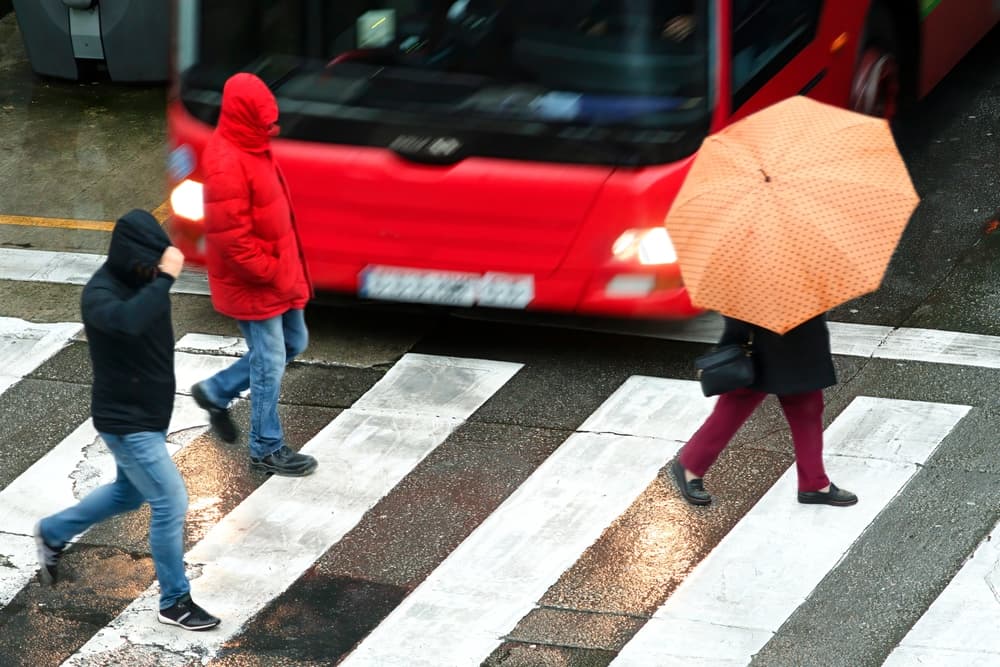EXPERIENCED PEDESTRIAN ACCIDENT LAWYERS

Whether you’re walking through the bustling streets of Broad Ripple, crossing intersections near Monument Circle, or commuting on foot near the IUPUI campus, the risk of a serious pedestrian accident is never far away. Indianapolis is a growing, walkable city—but that doesn’t mean it’s always safe for pedestrians. Being struck by a negligent driver can leave you injured, uncertain about what to do, and feeling defeated. You may be wondering what steps to take or who you can trust.
At Hurst Limontes, we understand how traumatic pedestrian accidents can be. Our Indianapolis pedestrian accident attorneys have decades of combined experience helping injured Hoosiers pursue justice after life-changing events. We can help you secure the compensation you deserve to rebuild your life. We serve clients in neighborhoods all across the city and surrounding areas—Carmel, Avon, Zionsville, Lawrence, and beyond.
If you or someone you love was hit by a car while walking or biking, reach out to us today for a free consultation. We’re ready to listen and help you take the next step toward justice.
Quick Navigation Menu
- Why Choose Hurst Limontes for Your Indianapolis Pedestrian Accident Case?
- Important Things to Do After a Pedestrian Accident in Indianapolis
- Indianapolis Pedestrian Accident Statistics
- Do I Have a Pedestrian Accident Claim?
- Injuries Commonly Associated with Pedestrian Accidents
- Where Do Most Pedestrian Accidents Happen in Indianapolis?
- What Compensation Is Available to Pedestrian Accident Victims?
- Let Us Handle the Insurance Companies
- How Can a Lawyer Help with My Indianapolis Pedestrian Accident Case?
- Frequently Asked Questions
- Our Indianapolis Pedestrian Accident Lawyers Are Ready to Help You
Why Choose Hurst Limontes for Your Indianapolis Pedestrian Accident Case?

Choosing the right attorney after a pedestrian accident shouldn’t just be about legal knowledge; it should be about trust, results, and compassionate service. At Hurst Limontes, our pedestrian accident attorneys treat every client like family from the moment they contact our firm. We’ve been representing injured pedestrians and accident victims across Indiana for over 40 years and have recovered hundreds of millions in compensation for our clients.
Here’s what sets us apart:
- Over a century of combined legal experience focused 100% on injury cases.
- No fee unless we win. You pay nothing out of pocket. We only get paid if we recover compensation on your behalf.
- Hundreds of 5-star reviews and a stellar reputation across Indiana.
- Personal, dedicated service. You won’t be passed off to a case manager—you’ll work with attorneys who care about your case.
- Fluent Spanish services. Attorney Alexander Jesús Limontes has represented thousands of Latinos in Indiana and is fluent in Spanish.
- A proven record of success, including multi-million-dollar settlements for clients hit by trucks, buses, and distracted drivers.
When you choose Hurst Limontes, you’re getting a legal team that knows Indiana law, understands how to fight insurance companies, and genuinely cares about helping you move forward.
Important Things to Do After a Pedestrian Accident in Indianapolis

If you’re reading this, it’s likely you or a loved one has already received medical care. That’s the right first step. But what comes next can make a big difference in whether or not you recover full compensation for your injuries.
Hiring an attorney as soon as possible is one of the most important steps you can take after being injured by someone else’s negligence. A lawyer can immediately begin investigating the crash, preserving evidence, interviewing witnesses, and handling the insurance company.
While your lawyer will handle the legal work, there are some things you should and shouldn’t do to protect the value of your claim:
- Write down what you remember about the incident while it’s still fresh in your mind. Include details like the time of day, weather conditions, traffic signals, and anything the driver said or did. A written account can preserve important facts that might fade from memory over time.
- Keep all medical appointments and complete recommended treatments, including physical therapy, imaging, and follow-ups. Insurance companies may use skipped appointments or gaps in care as an excuse to minimize or deny your claim.
- Keep a written or video journal to document your recovery. Record your pain levels, physical limitations, emotional struggles, and how your injuries affect your daily life. Doing this can provide compelling evidence of your suffering and loss of quality of life.
- Save evidence, such as clothing worn during the accident, photos of the scene, and any damage to personal property. If possible, take pictures of any visible injuries and the vehicle that hit you. Collect names and contact information for any witnesses.
- Avoid posting about the accident or your injuries on social media. Insurance companies may monitor your online activity and use posts to undermine your credibility or suggest your injuries aren’t as severe as claimed.
- Do not discuss your case with the other party’s insurance company. After obtaining legal representation, simply direct insurance adjusters to talk to your lawyer instead.
Each of these steps can make a difference in building a strong case and maximizing your recovery.
Indianapolis Pedestrian Accident Statistics

Pedestrian safety is a growing concern in cities across the country, and Indianapolis is no exception. In fact, pedestrian accidents have reached a crisis point in the city. In a recent three-year period, annual totals of pedestrian and bicycle accidents combined climbed from 455 to 684 to 783, resulting in an average of more than 43 deaths in Indianapolis each year.
For every pedestrian accident death, several more survivors are left with serious injuries.
Also of note:
- In one recent year, there were over 1,000 pedestrian-related crashes in Indiana, with more than 100 resulting in death or serious injury.
- Marion County consistently ranks among the highest in the state for pedestrian accidents.
- Urban areas, especially those with high foot traffic and poor infrastructure, remain the most dangerous for pedestrians.
These aren’t just numbers; they represent people whose lives were turned upside down in an instant and whole families that suffer as a result. Our firm is working with pedestrian accident victims to change that by holding negligent drivers accountable.
Do I Have a Pedestrian Accident Claim?

In most personal injury cases, including pedestrian accidents, liability comes down to negligence. In legal terms, negligence means someone failed to act with reasonable care, and that failure led to harm.
To have a valid pedestrian accident claim in Indiana, you generally need to prove four things:
- Duty – The driver owed you a duty of care (which all drivers do).
- Breach – The driver failed to uphold that duty by acting carelessly (for example, speeding, distracted driving, drunk driving, running a red light).
- Causation – That failure caused your injuries.
- Damages – You suffered actual harm as a result (such as physical injury, medical bills, or lost wages).
Pedestrian accident cases can be complex, especially when fault is shared. Perhaps you stepped into a crosswalk before the light changed at the same moment a car sped through the intersection to avoid stopping. Indiana has rules about shared fault, and in most cases, you can still recover compensation even if you shared part of the blame.
Injuries Commonly Associated with Pedestrian Accidents

Unlike drivers or passengers in vehicles, pedestrians have no protection from impact. That means injuries are often severe, even at low speeds. The human body simply isn’t designed to withstand the force of a moving vehicle.
Some of the most common injuries we see in pedestrian accident cases include:
- Traumatic brain injuries (TBI) – from hitting the windshield or pavement
- Spinal cord injuries (SCI) – which can lead to paralysis or long-term mobility issues
- Broken bones and fractures – especially to the legs, ribs, and arms
- Internal organ damage – including internal bleeding
- Severe orthopedic injuries – requiring multiple surgeries
- Lacerations and road rash – may lead to deep infections and scarring
- Soft tissue injuries – such as torn ligaments and muscle damage
In the most tragic cases, pedestrian accidents can be fatal. When this happens, families may have the right to bring a wrongful death claim for loss of companionship, lost financial support, and funeral expenses.
Where Do Most Pedestrian Accidents Happen in Indianapolis?
While pedestrian accidents can happen anywhere, certain areas of Indianapolis pose a much higher risk due to traffic patterns, poor lighting, speeding, or lack of pedestrian infrastructure. If you walk or bike around the city, these are some hot spots to be mindful of:
- Washington Street and Meridian Street intersection – A high-traffic zone in the heart of downtown with frequent foot traffic and turning vehicles.
- East 38th Street near Keystone Avenue – A known corridor for accidents involving pedestrians due to fast-moving traffic and limited safe crossing options.
- College Avenue near Broad Ripple Village – This popular dining and nightlife area sees heavy foot traffic, especially at night, which increases risk.
- Capitol Avenue near IU Health Methodist Hospital – A busy urban area with pedestrians accessing medical offices, public transportation, and parking structures.
- Madison Avenue and Hanna Avenue – Near the University of Indianapolis, this area combines high student foot traffic with inconsistent driver behavior.
Many pedestrian accidents occur in areas where drivers aren’t expecting to stop, where lighting is poor, or where designated crosswalks are inadequate. The Indy Pedestrian Safety Crisis website provides a map of the pedestrian accidents that occur throughout Indianapolis.
Our legal team investigates every accident site to identify all contributing factors and hold the responsible parties accountable.
What Compensation Is Available to Pedestrian Accident Victims?

When you’re injured in a pedestrian accident, the impact extends beyond the physical trauma. You may be unable to work, struggle with medical bills, or deal with emotional pain that lingers long after your injuries heal.
Economic damages may include:
- Medical bills (past and future)
- Lost wages and loss of earning capacity
- Physical therapy and rehabilitation
- Out-of-pocket expenses (transportation, home modifications)
Non-economic damages may include:
- Pain and suffering
- Emotional distress
- Loss of enjoyment of life
- Permanent disfigurement or disability
If your loved one was tragically killed in a pedestrian accident, your family may be able to file a wrongful death claim. These cases can seek compensation for funeral expenses, loss of financial support, and the emotional toll of losing a family member.
Our firm works closely with experts to calculate full and fair damages, so that no expense or loss is left out of your claim.
Let Us Handle the Insurance Companies
Dealing with insurance companies after an accident is rarely straightforward. Insurance adjusters may seem friendly or helpful at first, but their job is to settle claims for as little money as possible. If you speak to them without legal representation, they may use your words against you or pressure you to accept a lowball offer before you know the full scope of your injuries and losses.
At Hurst Limontes, we handle all communications and negotiations with the insurance companies. Our personal injury lawyers know how to challenge their methods, present strong evidence, and fight for a settlement that reflects the true value of your losses. If they refuse to offer you a fair deal, we are fully prepared to take your case to trial.
Unlike some firms that avoid courtrooms, we’re known for our trial experience and aggressive advocacy. This often leads to faster and more favorable settlements because insurers know we won’t back down.
How Can a Lawyer Help with My Indianapolis Pedestrian Accident Case?
Your attorney plays a key role in building your case, protecting your rights, and guiding you through each step of the legal process. At Hurst Limontes, here’s how we can help you:
- Investigate the accident and gather evidence like surveillance footage, police reports, and witness statements.
- Consult with medical experts to assess your injuries and long-term prognosis.
- Handle all negotiations with the insurance company.
- File a lawsuit and take your case to court if necessary.
- Help you access medical treatment and resources during your recovery.
Our goal is simple: to relieve your legal burdens so you can focus on healing.
Frequently Asked Questions
Our Indianapolis Pedestrian Accident Lawyers Are Ready to Help You

Alexander Limontes, Indianapolis Pedestrian Accident Attorney
If you’ve been injured while walking in Indianapolis or the surrounding areas, don’t wait for the insurance company to decide what your case is worth. Let Hurst Limontes put over a century of legal experience to work for you.
Our Indianapolis personal injury lawyers understand what’s at stake and are ready to help. We’ll handle the legal process and pursue the full and fair compensation you deserve for all you’re going through.
We take pride in treating every client with the attention and respect they deserve—because to us, you’re not a case number. You’re someone whose life has been disrupted, and we’re here to help you put it back together.
Call us at Hurst and Limontess today at (317) 636-0808 or reach out online for a free, no-pressure consultation.
Hurst Limontes LLC – Indianapolis Office
50 S Meridian St Suite 600
Indianapolis, IN 46204
P: (317) 636-0808


